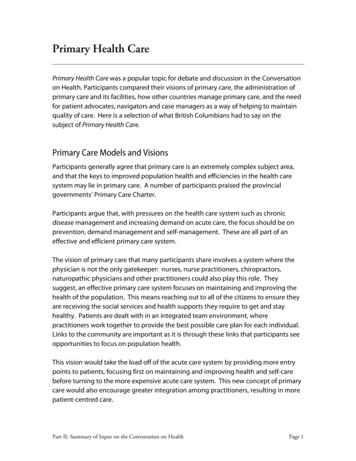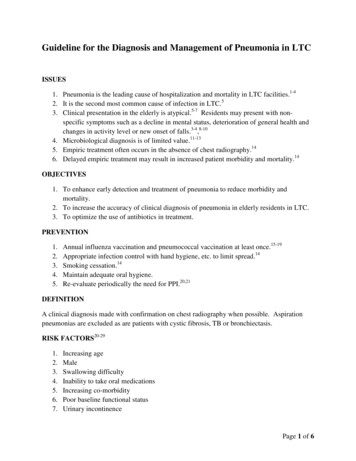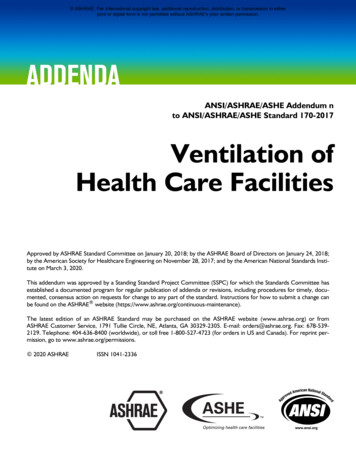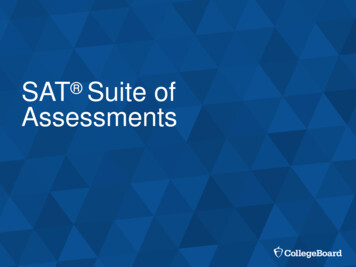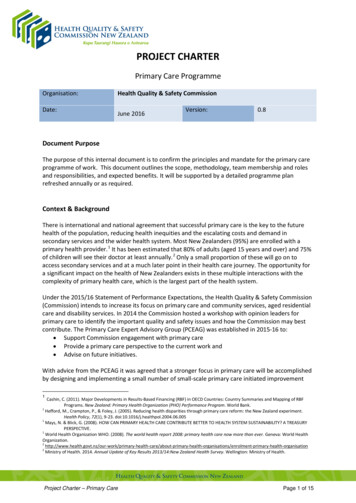
Transcription
Health Assessmentsin Primary CareA How-to Guide for Cliniciansand Staff
Health Assessments in Primary CareA How-to Guide for Clinicians and StaffPrepared for:Agency for Healthcare Research and QualityU.S. Department of Health and Human Services540 Gaither RoadRockville, MD 20850www.ahrq.govPrepared by:University of Colorado School of Medicine, Department of Family Medicine, theColorado Health Outcomes Program, and the Shared Networks of CollaborativePractices and Partners (SNOCAP)Contract No. HHSA29020071008Authors:Douglas H. Fernald, M.A.Adam G. Tsai, M.D., M.S.C.E.Betsy Vance, M.P.H.Katherine A. James, Ph.D., M.S.C.E., M.S.P.H.Juliana Barnard, M.A.Elizabeth W. Staton, M.S.T.C.Wilson D. Pace, M.D.David R. West, Ph.D.AHRQ Publication No. 13-0061-EFSeptember 2013
DisclaimerThis toolkit is based on research conducted by SNOCAP-USA under contract to theAgency for Healthcare Research and Quality (AHRQ), Rockville, MD (Contract No.HHSA29020071008). The findings and conclusions in this document are those of theauthors, who are responsible for its content, and do not necessarily represent the viewsof AHRQ. No statement in this report should be construed as an official position ofAHRQ or of the U.S. Department of Health and Human Services.The information in this report is intended to help clinicians, employers, policymakers,and others make informed decisions about the provision of health care services. Thisreport is intended as a reference and not as a substitute for clinical judgment.Public Domain NoticeThis document is in the public domain and may be used and reprinted withoutpermission.ii
AcknowledgementsSNOCAP-USA is grateful to the primary care practices that participated in the pilotproject and freely shared their experiences so that future practices could learn. We wishto extend our thanks to each practice for their hard work and effort, as well as theirwillingness to participate in the evaluation: Belmar Family Medicine Emory Family Medicine Exempla Capitol Hill InternalMedicine Exempla Green Mountain FamilyMedicine Exempla Oasis Family Medicine Family Care Medical CenterFoothills Family MedicineRocky Ford Family Health, LLCSheridan Health ServicesUniversity of Colorado Family Medicine,Park Meadows Walsh Medical ClinicWe also thank the practice-based research networks—and their clinicians and staff—including Building InvestiGative practices for better Health Outcomes ResearchNetwork (BIGHORN), the Colorado Research Network (CaReNet), the High PlainsResearch Network (HPRN), and the American Academy of Family Physicians NationalResearch Network (AAFP NRN). We extend special thanks to Richard Ricciardi, Ph.D.,N.P., who provided outstanding support, direction, and feedback throughout thisguide's development and production.iii
Table of ContentsIntroduction . 2Section 1. How Ready is Your Practice to Implement a New Health Assessment? . 5Section 2. How Does Your Practice Choose an Assessment? . 9Section 3. How Do You Work Health Assessments into Your Office Workflow? . 13Section 4. How Do You Use the Health Assessment Information You Collect? . 19Section 5. How Do You Activate and Engage Patients in Using Their Health AssessmentInformation? . 23Section 6. How Does Your Practice Sustain Health Assessments? . 27Appendices . 31Appendix 1: Background on Health Assessments in Primary Care . 32Appendix 2: Health Assessment Case Study . 33Appendix 3: Health Assessments for Adults . 35Appendix 4: Adult Health Assessment Sample Questions . 37Appendix 5: Assessments for Children. 42Appendix 6: Assessments for Adolescents . 43Appendix 7: Health Assessments for Seniors . 44Appendix 8: Crosswalk of Health Assessments Related to Incentive and Quality Programs 47Appendix 9: Tools for Making Changes in Your Practice . 49Appendix 10: Health Assessment Information for Patients . 51Appendix 11: Patient Feedback Survey Example. 53References . 53v
IntroductionObtaining periodic health assessments on patients provides an opportunity for primarycare teams to get a snapshot on the health status and the health risks of empanelledpatients. Health assessment is a process involving systematic collection and analysis ofhealth-related information on patients for use by patients, clinicians, and health careteams to identify and support beneficial health behaviors and mutually work to directchanges in potentially harmful health behaviors. Health assessments are not intendedto be diagnostic tools and they are not complete health histories; instead, they aim to beone method to engage patients in their own health, leading to better health choices andimproved health behaviors in the long term.Much of the research on health assessments has focused primarily on their use andapplication in work settings. In these settings, successful use of health assessmentsrequires assessments of health risks combined with health education programs.However, effective use of health assessments in primary care will require broaderadoption and better implementation, including assessment, review, feedback andfollow-up support for patients.There are a variety of reasons to spark primary care practices to begin implementationof health assessments. For example, primary care practices may want to 1) systemicallyidentify health issues in their patients, 2) take advantage of incentives provided byinsurers or accrediting agencies, 3) implement the Medicare Annual Wellness Visit(AWV),1 or 4) support national initiatives like the National Committee for QualityAssurance (NCQA) Patient Centered Medical Home (PCMH) Recognition Program andthe Centers for Medicare & Medicaid Services meaningful use standards.2 Thus, thepurpose of this guide is to provide a framework and practical evidenced-based guidancefor primary care teams to adopt and successfully implement health assessments inprimary care practices.Additional background information on health assessments can be foundin Appendix 1 (p. 32).Who Should Use This Guide?This guide is designed to be used by a team of clinicians and staff in a practice. Theguide can help: Practices with limited experience in implementing health assessments.1
Practices that have struggled with implementing health assessments in the past.Practices experienced in implementing health assessments.Practices with extensive experience can benefit from this guide by reviewing keydecision points and reminders about effective change strategies and processes.How to Use This GuideTo use this guide effectively, first identify the health assessment “champion” or leadin your practice. The lead should: Review this entire guide to become familiar with its overall contents and process.Set aside a minimum of one hour for this task.Make notes in the guide for you and your team.Review the key decision points below.Seek guidance from the rest of your practice team.Implementing a new health assessment effectively is not simply an “add-on” to the dailyroutine; it will have an impact on workflow, patient engagement, and office resources.Implementing health assessments is a process with “decision points” (shown below),from the early stages of health assessment selection and adoption to workflowintegration through ongoing maintenance. For an example of the process, see the briefCase Study in Appendix 2, p. 33.Is yourpracticeready? How do youHow do youintegratechoose an assessmentsassessment?into practiceflow? How do youuse theinformationyou collect? How do youHow do youinvolve sustain healthpatients?assessments?This guide provides guidance and tools for each of these decision points. Theappendices provide additional resources--including specific health assessmentquestions you can review, modify, and use--and links to other sources. Look for the bluebar in the margin and a link to the appendix location.2
The quotations highlighted throughout the Guide are from the clinicians, staff, andexperts who participated in a field test of the guide or in the best practices datacollection.How Was This Guide Developed?The content and recommendations in this guide follow from our observations andinterviews with primary care providers, staff, and administrators conducted in twophases across four practice-based research networks. In phase one, we combinedobservational data from six primary care practices about how they have implementedhealth assessments with results from a literature review, listserv discussions, twopatient advisory councils’ recommendations, and expert panel recommendations. Thecombined results were used iteratively to develop a complete implementation guide. Inphase two, the “How-To” Guide was field tested in another group of eight primary carepractices. Observational data were again collected during the field test to further refinethe content and organization of the guide based on user experiences3
Is yourpracticeready?1How do youchoose anassessment?2How do youintegrateassessmentsinto practiceflow?3How do youuse theinformationyou collect?4How do youinvolvepatients?5How do yousustain healthassessments?6Section 1. How Ready Is Your Practice toImplement a New Health Assessment?How do you know if your practice is ready to start work on implementing a healthassessment? Answer the questions below to help identify areas where morepreparation is needed.Table 1: A Checklist to Evaluate Your Practice ReadinessQuestions for Your Practice or TeamYesNoWhere to Find Helpin This GuideDo most clinicians and staff in your practice agree thatimplementing a health assessment is an importantissue?Section 1 (this section):benefits of implementinghealth assessmentsIs your practice prepared to commit resources to theprocess of implementing a new health assessment?Does your practice have an idea of where the healthassessment will fit into your practice’s current workflow?Section 2: health assessmentselection and resourceconsiderationsSection 3: workflow integrationstrategiesDoes your practice have a plan for how the data fromthe health assessment will be used once it is collected?Section 4: approaches to usinginformation with your patientsHow will your practice organize its resources (internaland external) to provide care based on the results of thehealth assessment?Section 4: approaches to usinginformation with your patientsHas your practice thought about ways to engage yourpatients in the health assessment process (review ofresults, prioritization, action plan, etc.)?Section 5: strategies forengaging patients with healthassessment informationHas your practice considered how it will sustain andimprove the health assessment?Section 6: tips for sustaininghealth assessmentsIf you found yourself marking “No” more often than “Yes”, you may need to addressthose barriers before moving forward on a full health assessment implementation. If5
the barriers are relatively minor, some education may help. Below are some ideas tohelp weigh the pros and cons of adopting and implementing a new health assessment.Benefits of Routine Health Assessment Improve relationships with patients by using the data to stimulate dialogue.Help clinicians identify and prioritize patient health issues and health goals.Help pinpoint focused messages when talking with patients about what mattersto their health.Help patients understand their current health status and act to improve theirhealth.Consistently remind patients to increase their awareness about specificbehaviors and habits that affect their health or chronic conditions.Track patient health behaviors over time (e.g., physical activity, smoking, stress,or quality of life), which can also help with patient follow-up.Measure and monitor patient data at the practice/population level for proactive,planned care.Identify issues requiring patient referral to additional resources.Fulfill requirements for and generate revenue from incentive programs andnational guidelines.Don’t be afraid of the information you are going to start seeing. You will havebetter insight and probably learn more about your patients, thus building a farbetter relationship with your patient than you may have thought possible.- Practice manager, urban private practice, ColoradoChallenges of Routine Health Assessments Selecting an instrument that is meaningful, but practicable.Dedicating time and training (including technical assistance if using EHR)required to effectively integrate health assessment into the practice workflow.Accepting the practice work flow interruptions that may occur during the earlyimplementation phase.6
Identifying a method to analyze and prepare data for easy and expedient use bythe health care team.Prioritizing and addressing a patient’s identified health risks.Organizing and deploying appropriate staff and resources to intervene on andtreat identified health risks.Documenting and coding correctly in order to receive incentives and facilitateappropriate referrals.There is a balance: You don’t want to have to do too much routinely. Right nowwe have to do a lot of documentation for “meaningful use,” which is a burden. Iam very sensitive to adding to this burden. Yet, I also can see the importance ofhaving this information for reaching public health goals and collection of data.- Family physician, suburban private practice, Colorado7
Is yourpracticeready?1How do youchoose anassessment?2How do youintegrateassessmentsinto practiceflow?3How do youuse theinformationyou collect?4How do youinvolvepatients?5How do yousustain healthassessments?6Section 2. How Does Your Practice Choose anAssessment?Many health assessments are available, so the choice may seem overwhelming. Thinkabout ways to start small by focusing on a specific group of patients. This sectionprovides guidance on how to select a health assessment that is appropriate for yourpatient population and practice situation. The first step is to identify your practice’spriorities in two areas: the type of patients you want to focus on and the healthconcerns you routinely discuss with those patients.This is what [my staff] and I have talked about: “How do we want to do [ourassessment]?” You’ve got to think about who you are going to [assess]; and then,you think about, “What are we going to do when we get the answers?”- Family nurse practitioner, rural private practice, ColoradoThe following questions will help you select a health assessment while making sure theassessment you choose includes questions important to your practice.1. Which patient group is most important to your practice to begin assessingmore routinely now? AdultsSeniorsAdolescentsChildrenOther:9
2. What specific health concerns do you want to more systematically ask theabove patients about? Depression and anxietyHealthy eating and physical activitySocial support or social isolationAlcohol or substance abuseSexual activityTobacco or smokingPersonal safetyPainConfidence or ability to manage their own healthQuality of lifeOther health behaviors, risks, or concerns:3. What are your practice constraints in conducting health assessment?Are you constrained by any of the following factors? The time required for you and your staff to conduct the assessment(s) The potential for reimbursement The health risk questions already in your electronic medical record Other quality improvement initiatives that may be ongoing within your practice:4. How will you and your health care team act on the results of healthassessment?When thinking about the types of questions you may ask, you must consider how yourteam will act on the results. What resources does your practice have to follow up and treat conditionsidentified by the assessment?Which care team members can help to identify resources for patients for specifichealth concerns?10
The work of addressing risks identified on a health assessment does not have to fallentirely on clinicians or practice staff. Community and online resources may beavailable to help activate and engage patients with addressing behaviors such assmoking or weight loss. Which resources outside the office can your practice connect patients to (e.g.,community or web-based resources)?How else can your practice staff activate and engage patients when a healthconcern has been identified (e.g., motivational interviewing techniques,protocols for planned follow up)?After answering the above questions, you should now have a good idea of the type ofassessment you want to implement. The next step is to determine the exact assessmentto conduct in your practice. The Appendices contain many types of sample questionsand additional resource links.Appendix 3 (p. 35): Adult health assessment resourcesAppendix 4 (p. 37): Sample questions for adult health assessmentsAppendix 5 (p. 42): Child health assessment resourcesAppendix 6 (p. 43): Adolescent health assessment resourcesAppendix 7 (p. 44): Information about the Annual Wellness Visit andassessments for seniorsYou don’t want to ask questions if you’re not prepared to address them; thatis, don’t ask if you won’t review and act on it, especially if you lack theresources to address the problem.We ask about violence in our preventive care question set. Although positivesare uncommon, we recently did catch one instance of domestic violence thatwe were able to address that we wouldn’t have caught otherwise-Family physician, suburban private practice, New Jersey11
Are you already collecting this information?Several quality improvement or recognition programs require documenting orreporting specific information about your patients. Some of the items required maycontain elements of health assessments, though they are often incomplete. Here aresome common programs in primary care and their related health assessment items.Table 2: Health Assessments Related to Incentive and Quality ProgramsComprehensiveHealthAssessmentItemsAlcohol UseDepressionFall RiskPhysical ActivityTobacco ulUse - ures2011The JointCommissionCore MeasureSetsUSPSTF“A” or “B”GradeRecsXXX2XXXX2XXX2XXX3XX22PCMH: Requirement 2C Comprehensive Health Assessment includes “Behaviors affecting health”Includes assessment and follow-up action (e.g., referral, counseling, other intervention)3Medicare patients only2A complete crosswalk can be found in Appendix 8 (p. 47).If you are already using a health assessment in your practice, like those listed in thetable above, you may find you can augment it with a specific health assessment tool toconduct a full health assessment with your patients.The hospital requires certain information to be collected on each patient atevery visit, which drives most of the content and questions the practice asks. Thepractice then decides how to collect the data and enter it into the EHR. Thepractice may add additional questions to the form that they feel are relevantand already exist in the EHR as fields. At the practice level, staff and providerswork together to tweak the questions to fit their practice.- Medical assistant, suburban university-affiliated practice, Colorado12
Is yourpracticeready?1How do youchoose anassessment?2How do youintegrateassessmentsinto practiceflow?3How do youuse theinformationyou collect?4How do youinvolvepatients?5How do yousustain healthassessments?6Section 3. How Do You Work Health Assessmentsinto Your Office Workflow?Now that your practice has identified which health assessments to incorporate intoroutine patient care, the next step is to consider how the assessment fits into the patientvisit workflow. If this still feels overwhelming, start with a small pilot test, then moveforward sequentially. This section is organized into five subsections addressing keystrategies for implementing health assessments into the workflow of the patient visit:practice-wide involvement, training, patient visit planning, standardization, andEHR integration.Start small. For instance, have one doctor who is interested in [a newassessment] and owns, and hones it to perfect, and then presents it [to the restof the staff].-General internal medicine physician, urban private practice, ColoradoIs your whole staff involved in the implementation?Implementing a new health assessment—like many practice improvement efforts—works best as a team effort. Clinicians, staff, and managers must all be involved in thefinal decisions about how an assessment will be implemented. To achieve this, engagestaff and clinicians throughout the entire process of testing and improving how tools orquestions are integrated into the office flow. In a larger practice, it might be morepractical to do some of the work in a smaller team, bringing in the whole practice at keydecision points. Multidisciplinary teams, regular meetings, plan-do-study-act (PDSA)cycles, and ongoing reviews of office processes will help to:13
Share the planning, design, execution, and maintenance of implementing healthassessmentsSpread the effort and responsibility for handling health assessments across thehealth care teamLinks to PDSA and Workflow tools can be found in Appendix 9 (p. 49).Our recommendations are: 1. Figure out your workflow.2. Assess what you are going to do with the data you get.3. Determine what elements of health you are most interested in and knowhow to deal with the results most effectively.4. Start small and then expand.-Family physician, suburban private practice, New JerseyIn what areas do you need more training?Well-trained clinicians and staff will facilitate successful health assessmentimplementation. Staff might not immediately understand their important role ineffectively implementing health assessments; however, training staff, settingexpectations, getting buy-in from key leaders, and providing evidence on the value ofhealth assessments may help to overcome resistance. Train on both the completion ofhealth assessments and how to discuss results with patients. Consider providingtraining on the following: Patient engagement techniques (e.g., how to emphasize the importance ofcompleting the assessment and how to explain how the information is used)Specialized EHR training (e.g., work flows, templates, and reporting)Issues specific to the selected health assessment instruments (e.g., scoring,decision support, patient feedback)Implementation (e.g., work flow, data entry, scheduling)Tracking and reporting (e.g., documenting in and reporting from EHR orregistry)How the selected health assessment(s) will improve patient care14
How will new health assessments affect patient flow?To succeed with a sustainable implementation, the workflow for health assessmentsshould aim to streamline the patient visit, improve (or at least not increase) patientcycle times, maximize clinician-patient contact time, and improve the use of patientcontact time. With some careful planning, this can be accomplished. Allow a patientenough time to complete the health assessment thoughtfully, whether that meansallowing them to complete it at home before the visit (possibly using a family memberto help) or having them complete it in the waiting room while they wait to be seen. Hereare a few considerations: Best types of visits for patients to complete a health assessment (e.g., wellvisit, sports physical)Options for completing the survey outside of the office (e.g., mail to patientsprior to a visit or complete online)Staff availability to help patients complete health assessments (e.g., MA/RNreviews and asks about unanswered questions) Options for review of the completed health assessment (e.g., MA/RN as partof rooming process or while patients wait; scan completed paper surveys;review EHR template or report) Acknowledging to patients that you received and reviewed the information Formatting and ordering of questions to ensure efficient review or dataentry (e.g., reorder questions to fit with EHR data entry work flow, organize“positive” responses in the same column for quick visual scanning)Working collaboratively with patients to create a care plan (e.g., templatesor handouts with health goals, priorities, and action items)Coding appropriately for administration and review of health assessments(e.g., preventive coding “cheat sheet” for staff or clinicians)15
Should you standardize your processes?We identify Annual Wellness Visit patients before their visit so the correctmaterials can be sent. The patient is sent an Annual Wellness Visitquestionnaire ahead of time to fill out before they arrive in the clinic. Theaverage patient takes about 10 minutes to complete [the questionnaire]. So far,most patients come back with the questionnaire already filled out.- Family physician, urban residency practice, GeorgiaConsider developing a process map to visually describe the complete health assessmentprocess in your practice. A sample process map can be found in Appendix 9 (p. 49).Standardization of processes, especially establishing expectations for roles andresponsibilities, is important for practices to implement health assessments completelyand more routinely. Consistency in processes can be especially important whendocumentation of health assessment questions is required for incentive programs.Writing a brief protocol, guide, or checklist can help the health care team to learn howto work with health assessments. Here are some ways to think about standardizingyour health assessments: Which patients (or groups of patients) should receive the healthassessment? Who will make sure the patients get the health assessment? How(checklists; EHR reminders)? How often do patients complete the health assessment (e.g., at all well careor preventive visits; annually for patients with chronic conditions)? Where will the data go (into your EHR; into a database; into a paper chart)? Who on your team will primarily review the information with the patient?When? How will your practice arrange patient follow up?16
Special considerations for integrating health assessmentsinto EHR work flowsHealth assessment data are more useful when they can be stored in structured fields inthe EHR and retrieved through queries or reports. Integration into the EHR allowscomputerized tools to generate standardized decision support to identify healthbehavior risks and guide behavior change recommendations. Integration may alsoinclude using administrative databases to identify high-risk patients for furtherassessment or follow-up and support for accurate coding and billing. Consider thequestions below to help guide the integration of health assessment into your practice’sEHR: What health assessments (or specific questions) are already in your EHR? Do you already have a template for the health assessment? Does your EHR have a patient portal to collect health assessment data? What can you learn about implementation strategies from other practicesusing your same EHR? If entering data from paper forms, do your paper forms follow EHRworkflows? Are answers to confidential or sensitive questions stored in a way to avoidimproper release of this information? Does the EHR allow the data from the health assessment to be easilycollected for reporting (e.g., quality improvement or populationmanagement)?In some cases, EHR integration might not be practical. Integration with EHRs is notessential—paper can still work well and be efficient for some assessments. Forexample, a paper health assessment form can be a quick and effective reminder tool forboth clinicians and patients to discuss a particular topic that could be affecting thepatient’s health.Do you have an alternative to the EHR?While integrating health assessments into your EHR is desirable in the long term, itcould be more practical to consider some alternatives: Standalone data repository (e.g., a patient registry)Simple spreadsheet or database17
Web-based tools for gathering and storing the health assessmentinformationBe sure that any electronic files you create are secure and comply with patientprivacy regulations.It is not easy to find [information] in the EMR so it is rarely used. Also, sincepatients cannot input the data directly, it takes time to ask the questions. It iseasier to have the patient fill this out on paper and put the final number resultin [the EMR] as data.-Family physician, suburban residency practice, New York18
Is yourpracticeready?1How do youchoose anassessment?2How do youintegrateassessmentsinto practiceflow?3How do youuse theinformationyou collect?4How do youinvolvepatients?5How do yousustain healthassessments?6Section 4. How Do You Use the Health AssessmentInformation You Collect?How you use the information you gather depends on the type of information youcollected, what you want to achieve, and what resources
Obtaining periodic health assessments on patients provides an opportunity for primary care teams to get a snapshot on the health status and the health risks of empanelled patients. Health assessment is a process involving systematic collection and analysis of health-related information on patients for use
